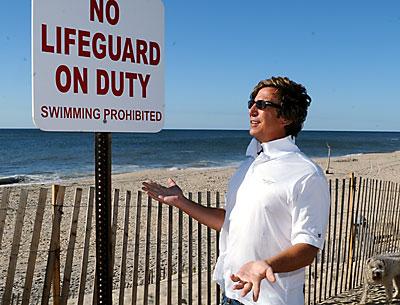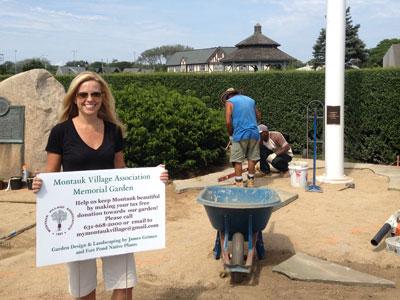West Nile Fears Prompt Aerial Spraying
West Nile Fears Prompt Aerial Spraying
Last Thursday’s announcement of a second confirmed case of the mosquito-borne West Nile virus in Suffolk this year arrived amid aerial pesticide spraying by the county and a furious reaction from those who fear the spraying endangers the environment and public health.
The latest West Nile case involves a resident of Huntington, who is recovering. The first person diagnosed with the virus, on Aug. 6, was a Babylon resident who has since recovered. While both cases occurred in western Suffolk, the Division of Vector Control of the County Department of Public Works has included eastern Long Island in its spraying program. Spraying has occurred in the Town of East Hampton, most recently on Aug. 21 over Napeague and Accabonac Harbor.
The use of insecticides including methoprene, commonly used as a mosquito larvicide, and resmethrin (also known as Scourge) to kill adult mosquitoes via low-altitude, large-droplet liquid application, is in keeping with the a long-term plan and environmental impact statement passed by the County Legislature in 2007 despite objections of environmentalists and the county’s Council on Environmental Quality.
“That was about a $4.6-million effort to comprehensively look at mosquito control in the county,” Dominick Ninivaggi, superintendent of the Division of Vector Control, said.
“The county is trying to act responsibly when it comes to West Nile virus, and with a minimal environmental impact,” Mr. Ninivaggi said. “It’s certainly effective in reducing the number of mosquitoes. One thing we looked at in the long-term plan is the level of activity. . . . We do know, by looking at our trap data and by looking over history, our program of larval control in salt marshes is extremely effective. Go to the wilderness area of Fire Island National Seashore, where we’ve done nothing for many years because it’s a wilderness. Our traps there will collect 10 to 100 times, sometimes 1,000 times, the number of mosquitoes we see anywhere else in Suffolk County.”
The insecticides being used are registered by the Environmental Protection Agency and the State Department of Environmental Conservation and they are said to be applied in accordance with state and federal permits. Mr. Ninivaggi cautioned that the small number of confirmed cases in Suffolk could be misleading. The time lag between a mosquito bite, the appearance of symptoms, a diagnosis, and a confirmation could mean that other cases will eventually be confirmed.
“We look at the surveillance data and try to decide where the balance is between acting to prevent disease and not over-reacting by spraying areas unnecessarily,” Mr. Niivaggi said.
Kevin McAllister, who, as the president of the nonprofit Peconic Baykeeper organization, is adamant in his opposition to the spraying. “I think it’s totally overblown with respect to controlling mosquitoes, and doesn’t have any discernible effect and reduction on West Nile, period.”
Mr. McAllister described an experience he had last week. “I was on the beach in the evening, the county was spraying the marshes along Moriches Bay. It was a helicopter, moving very slowly. I could tell it was a spraying event.” At the time, he said, there were no mosquitoes in the vicinity. “All of a sudden, the location I was sitting at became infested. The mosquitoes are basically getting out in front of the spray fog that they had released. This begs the question, ‘What’s the kill effect of these pesticides on mosquitoes?’ ”
According to Mr. McAllister, “a host of beneficial insects is being negatively affected.”
Wiltraud Salm of Southampton is among those who have lashed out about the spraying program. Her house is adjacent to Scallop Pond Preserve, a salt marsh that is part of the Sebonac Creek estuary and abuts the Cow Neck peninsula. The area has been preserved by the Peconic Land Trust. “The mosquitoes that live in the marsh fly away from the spray and come up to the house,” Mrs. Salm said. “Other than that, we don’t have any mosquitoes at the house.”
Ms. Salm accused the county of deliberately spraying her property. “They are sneaky; they say they will spray at a certain time, and then wait until I am elsewhere. I caught them every time, I quickly run out and shoo them away. If I don’t, they spray liberally everywhere.”
Mrs. Salm has written to Mr. Ninivaggi expressing her disapproval. In a letter dated Aug. 13, she accused the county of spraying right up to her house and asked, “Do I have to sue you for trespassing?”
Mr. McAllister has also written to Mr. Ninivaggi, asserting “you do not have the authority. . . to spray private lands with lethal pesticides without landowner authorization. . . . It is your obligation to respect [Mrs. Salm’s] wishes and keep your poisons off the privately owned Scallop Pond marshlands.”
Mr. Ninivaggi denied that the marshland treated in that area was her property. “I’ve already given her that information, so it’s a moot point, but the county does have authority to enter private lands to conduct mosquito control under public health law.”
Another development, one likely to amplify the debate, is the recent detection, as concluded in a study by the Connecticut Department of Energy and Environmental Protection, of methoprene and resmethrin residues in lobsters harvested from Long Island Sound. “The literature is full of the impacts of these products on aquatic life, fish, and invertebrates. The presence of pesticides in lobster is irresponsible and unacceptable,” Mr. McAllister said.
Scott Warren, an emeritus professor of botany at Connecticut College, had questions about the conclusion of the lobster study, however. “There have been assertions of insecticide as causal agents of lobster decline in Long Island Sound for some time, since the first real major decline occurred [in 1999]. A more problematic issue for lobsters in Long Island Sound is alleged to be water temperatures. They’re a cold-water species, and the water is getting a lot warmer, to a point where we’re flirting with what lobsters can deal with and remain healthy. In cold-water temperatures, the small amounts of pesticides might not have had much effect, but in a physiologically stressed condition, that could nail them.”
Mr. Ninivaggi conceded that the detection of the specific insectsides was a concern. However, he said the results of the study were yet to be confirmed. “Nobody who is knowledgeable on this subject can understand these findings, so the first thing we have to do is make sure these findings are real and not some sort of laboratory artifact. The county, as part of our E.I.S., looked at the ecological toxicity and behavior of the materials we use. What we found, both for resmethrin and methoprene, is that these materials degrade very rapidly in the environment. They don’t accumulate. With that information at hand, it’s hard to understand how these materials can be found in high concentrations in lobsters that are many miles from any application of these materials.”
Mosquitoes and lobsters are related biologically. “The impact of these pesticides on flying mosquitoes holds true for crustaceans,” Mr. McAllister said. “I’m not trying to dismiss illness or death associated with West Nile, but 40,000 people die a year from the common flu. Let’s put it in perspective: Is the prescription a lot worse than the actual ill?”
“We’ve done our own studies in cooperation with Stony Brook University and the United States Geological Survey,” Mr. Ninivaggi said. “They found that right after application these materials are at extremely low levels, and after hours or days are undetectable. We’re confident in these results.”
The county’s spraying program is occurring as Dallas has experienced 200 cases and 10 deaths related to West Nile this year.
“There’s no question that West Nile is a public health concern, that it can get out of hand,” Professor Warren said. “I can sympathize with the Vector Control people who look to Dallas and think, ‘Could it happen here?’ And if it did, the first thing people would say is, ‘Why didn’t you do something?’ . . . By the standards of DDT, Scourge is pretty nice, but they’re still insecticides. They have the potential to disrupt the metabolism of anything they land on.”



